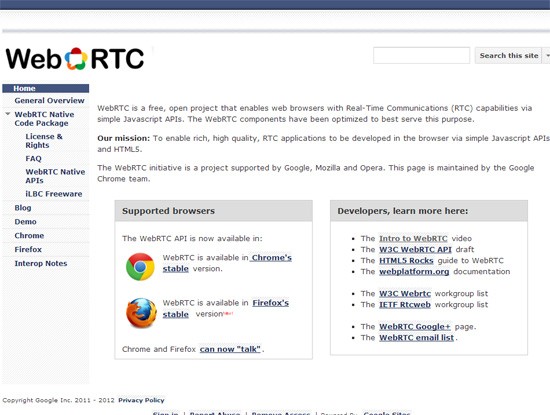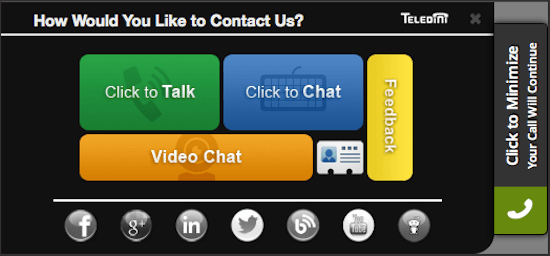WebRTC: An Opportunity for Entrepreneurial Web Developers - Six Revisions |
| WebRTC: An Opportunity for Entrepreneurial Web Developers Posted: 19 Aug 2013 03:00 AM PDT WebRTC, an open standard for real-time communication between web browsers, is a game-changing technology that’s projected to reach one billion devices by the end of 2013.
This emerging web technology is so popular right now that the recent WebRTC Expo had to expand twice to be able to accommodate what would eventually be over 700 attendees. While there are as many challenges as there are opportunities surrounding the success of the communication-enabled web browser, the WebRTC standard has already secured a strong foothold. Web developers should be taking notice. What is WebRTC?For those of you unfamiliar with WebRTC, I’ll provide you with a quick, high-level introduction. WebRTC is an open-source project that seamlessly enables real-time communication (RTC) in the backbone of modern web browsers. This means web developers can now utilize voice, video, and peer-to-peer connectivity via simple JavaScript APIs, with no additional plugins or installs required.
Led by Google, and released in Google Chrome version 23, the web technology has since been adopted by Mozilla and Opera, bringing it closer to its declared purpose, which is "to help build a strong RTC platform that works across multiple web browsers, across multiple platforms." Why You Should Get on the WebRTC BandwagonWhy is WebRTC important, and why should web developers be paying attention? Real-time communication is not a new concept, and proprietary closed-source services like Skype and Apple’s FaceTime are already household names. However, the interactions that existing RTC applications have facilitated for years are only a glimpse of what’s to come. We are on the verge of a merger between voice, video, and data — unified, open standard communications within the browser — and it’s going to be disruptive. Web developers should strive to learn about WebRTC because, where there is disruption in technology, there is opportunity for those of us at the forefront. Issues with Existing Real-Time Communication SolutionsUntil recently, real-time communication services were impeded by development and distribution challenges that were prohibitive to innovation. For example, developers fluent in proprietary communication technologies (think VoIP) could be hard to find, and thus expensive. Furthermore, once an application was developed, getting it in the hands of the end-user required them to download and install software or plugins, hindering distribution. Things have changed. Now, any web developer can build communication-enabled web apps using (relatively) simple JavaScript APIs, with no installs required for the user (as long as they’re using a modern, WebRTC-enabled web browser). Suddenly, small businesses and new entrepreneurs can compete in a communication industry once reserved only for corporations with millions of dollars in capital in the bank. WebRTC could revolutionize, for example, the way a small e-commerce website owner communicates with her online shoppers, or the way members of a web community like Reddit or Quora interact with one another. All of these new imaginations will bring forth new web services, innovative Internet business models, and will impact the way people interact with the Web and everyone on it. Some Businesses Are Already Betting on WebRTCConsider the business opportunities that WebRTC is opening up; Dialogic Inc. recently released the results of their WebRTC survey. The survey was administered to 169 key executives in the service provider and application development industries. 86.9% of the respondents indicated that WebRTC is significant in their product roadmaps. Interestingly, the survey found that most respondents predict the education industry (36%) will be the vertical market most likely to benefit from WebRTC, followed by adult entertainment (17%), online gaming (14%), healthcare (13%), financial services (11%), and, finally, hospitality (9%). Examples of online videogames utilizing WebRTC can already be found. For example, Google’s Cubeslam, which uses WebRTC for audio and video communication with the people you’re playing with, as well as to keep your game in sync, is a simple demonstration of how WebRTC can one day revolutionize online gaming.
There are also plenty of companies out there focused on sales, customer service, and collaboration applications, which to me seem among the most natural directions for the technology to progress. Here are some examples of Internet companies already focusing on WebRTC:
The Future of WebRTCIt isn’t difficult to imagine a world in which you click on a "Contact Us" link on a website and are then greeted with a representative on video asking how they can help out. Imagine that a user was performing their online banking and runs into an issue; with WebRTC, they could share their screen with one of the bank’s support agents and be walked-through in real-time towards a solution to their issue. Looking a support agent in the eye over your computer might seem unnerving to many consumers at first, but it might become the norm in the near future, if WebRTC takes off. As a web developer, you already know that you should always have your eye towards the future in order to keep your talents sharp and relevant. Though the success of the standard is far from certain, it’s a good bet that WebRTC will continue to gain traction in the web development community. The communication-enabled web browser is here to stay, and I look forward to seeing what new apps and companies are born from people like you. Learn About WebRTCCheck out the following resources for more information about WebRTC.
Related Content
About the AuthorThe post WebRTC: An Opportunity for Entrepreneurial Web Developers appeared first on Six Revisions. |
| You are subscribed to email updates from Six Revisions To stop receiving these emails, you may unsubscribe now. | Email delivery powered by Google |
| Google Inc., 20 West Kinzie, Chicago IL USA 60610 | |




 Max McChesney is the founder of
Max McChesney is the founder of
No comments:
Post a Comment